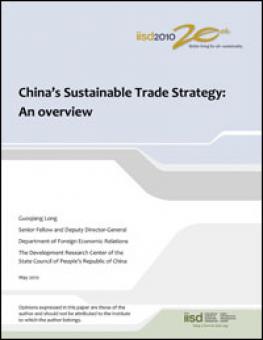
China's Sustainable Trade Strategy: An overview
China's emergence as a big player in world trade is a significant development in the global trade system.
China introduced its trade reform policy at the end of the 1970s when China ranked 32nd among nations in global trade, due to China's "Import Substitution" strategy. Thirty years later, China became the world's largest exporter.China's fast trade development is attributed to its implementation of a strategy and policy featuring "active absorption of foreign direct investments and encouragement of foreign trade development" for the sake of coping with global economic integration and international industrial relocation. This strategy has accomplished immense results; however, it has faced growing challenges. The swift expansion of China's economy has given rise to increasingly severe problems regarding resources, energy and the environment. Globally, the fast growth of China's trade volume has triggered an increasing number of trade frictions between China and other countries and caused relations between China and other countries to become more complicated.Under such new circumstances and in lieu of recent national changes and relations with the rest of the world, China must implement a sustainable trade strategy. In this paper, the author analyzes three areas of a sustainable trade strategy. Section 1.0 is a review of the evolution of China's foreign trade, Section 2.0 analyzes the challenges that China's foreign trade now faces, and Section 3.0 discusses the overall train of thought and main content of a sustainable trade strategy.
You might also be interested in
Can China Contribute to Climate Action in Latin America?
Sisi Tang discusses three climate action initiatives between China and Latin America: a crediting mechanism for clean energy, debt-for-climate swaps, and a greener free trade agreement.
Border Carbon Adjustments: Trinidad and Tobago country report
This report consolidates, analyzes, and presents views and perspectives of stakeholders from Trinidad and Tobago on border carbon adjustment (BCA) schemes to contribute to the global debate on BCA good practices.
Global Dialogue on Border Carbon Adjustments: The case of Brazil
This report consolidates, analyzes, and presents the views and perspectives of stakeholders from Brazil on border carbon adjustment (BCA) schemes to contribute to the global debate on BCA good practices.
Avoiding Trade Concerns in the Design of Plastic Pollution Measures
IISD provides insights on aspects of WTO members' plastics that have created friction with trading partners and suggests recommendations for the adoption of such policies in the future.